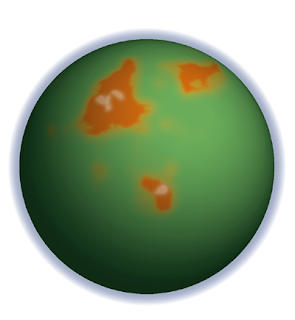I know, it's Sunday, but at least I got this part finished.
I haven't spent a lot of time discussing what was happening to the Earth itself during these couple of billions of years during which life was getting itself on the map, so to speak. You'll remember that at the beginning of this time, during the later Hadean, there wasn't a whole lot of land. What land existed was barren (of course) and probably pretty unstable. About four billion years ago, we're probably looking at a world map something like the image on the left.
Now,
at least one geologist has doubts as to whether we can actually call these landmasses from four billions years ago "continents."
As John Rogers sees it, three billion years is as far back as you can go in studying continents. Before that, they didn’t exist - not by his definition.
Traditionally, geologists determined the age of a continent based on the oldest exposed rock, which is some variety of granite. Because granites constitute the foundations of continents, geologists assumed that any granite found must date back to the continent’s formation. But Rogers, Kenan professor of geology, pointed out that granites were forming and being reworked into the crust before the crust was steady enough to sustain a continent.
“I kept saying that a whole pile of granites that is continually being destroyed is not a continent,” Rogers says. “It’s just a temporary pile of rock.”
He bases part of his argument on the ages of various parts of Pangaea, and it's worth looking at, but since Pangaea is much later than the period we're dealing with here, I'm not going to concern myself with it. What I am going to be looking at is a couple of processes involved in land formation.
Now, it may seem like a no-brainer, but it comes as a surprise to a lot of people to realize that one of the first natural phenomena on Earth, after the formation of what we'll call proto-continents, was rivers. Think about it: you have a hot planet that's cooling down, an atmosphere with a lot of water vapor, and a lot of variation in elevation: there's no reason to suppose that the earth's surface was flat, given that land formation was largely the product of volcanic activity: think Mt. St. Helens, or Vesuvius, or, for that matter, the Hawaiian Islands.
So, it starts raining. And raining. And raining. (Sorry, but forty days and forty nights isn't even in the running.) Two things are going to happen. The low places are going to fill up with water, and the water that falls on the higher places is going to run down to the lower places -- that is, we have rivers. And with rivers come sediments.
There are a number of contributing factors to erosion during this period. First, there's the action of rain itself, which, given the composition of the atmosphere -- carbon dioxide, water vapor, methane, and probably sulfides and other fairly corrosive compounds -- was more than likely, acid. While the rocks that existed were fairly resistant -- it's not easy to erode granite or basalt -- the acid rains had some effect. There is also evidence of glaciation as early as 2.9 billion years ago, and if there's one thing glaciers can do with great efficiency, it's erode rock.
So we have rivers, and we have sediment, and one thing that happens with sediment is that, as the rivers reach lower ground and slow down, the sediment drops out. This is especially true when the rivers reach the ocean. So we have sediments deposited in lowlands and in shallow oceans near rivers that are just waiting to become, in the first instance, soil, and in the second, rock.
(A fuller discussion of the climate and general conditions in the Pre-Cambrian can be found in the
Encyclopedia Britannica. It's exhaustive, and a little dense in place, so be warned.)
I'm still trying to pin down a point of origin for the critters that first developed exoskeletons -- not trilobites or crinoids, those are much too late, but the little prokaryotes that might have accreted shells of calcium carbonate to reinforce their cell membranes and/or to avoid being eaten by other prokaryotes. It seems likely that they occurred during the Pre-Cambrian, but there's vanishingly little evidence of exactly when, mostly due to the vagaries of our constantly shifting Earth.
Nevertheless, it seems fairly certain that they did make their appearance sometime during the Pre-Cambrian, and led to another very important part of land formation: limestone. I've heard estimates that 40% of the land on earth is limestone or derived from limestone, so you can see how important this is. As an illustration, the bedrock of Chicago is limestone, which shows that at one time this area was underwater. It's down there, and it's relatively recent -- we used to hunt for fossils in the gravel from the quarries near where I grew up, and would find things like bits of crinoid stems and the like -- but it's an important part of the geology of the region.
So, we got land forming, continents moving around -- and growing, and the Earth itself becoming more stable and more like what we know today. The stage is set for the Cambrian explosion, which we'll be looking at soon.



 Larry Mishel
Larry Mishel 














 Jamie Clayton
Jamie Clayton







